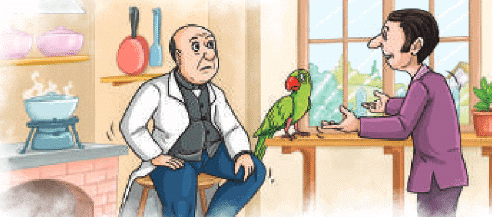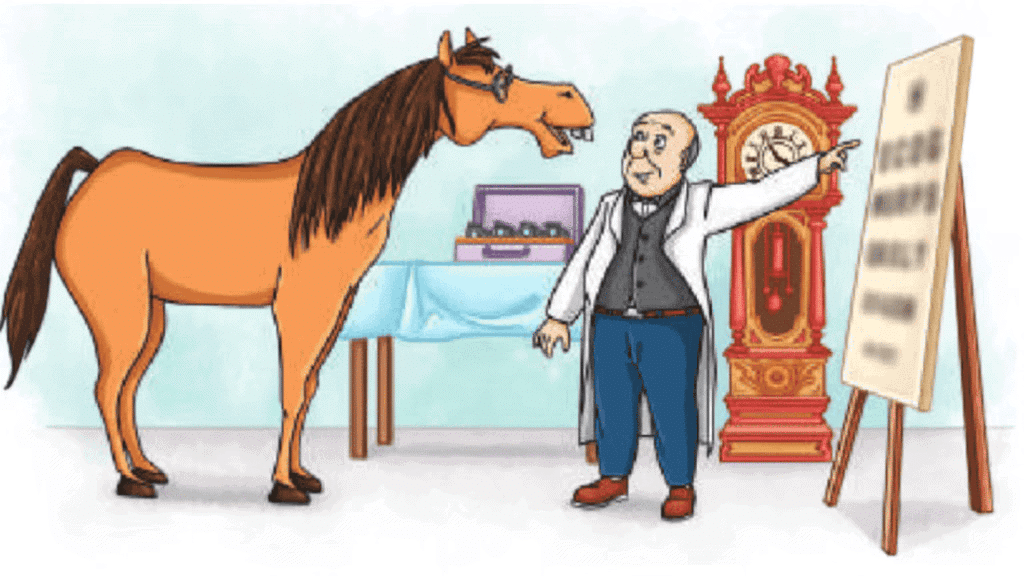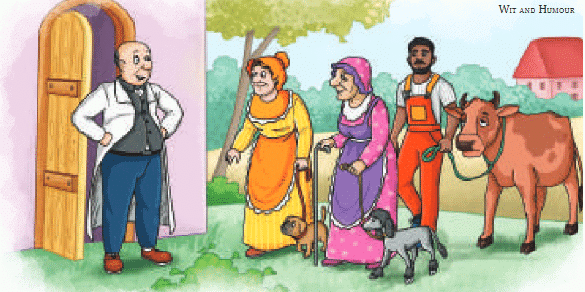Class 7 English Unit 2 Short and Long Answer Questions - Animals, Birds and Dr. Dolittle
Short Answer Questions
Q1: Why does the Cat’s-food-Man suggest Dolittle become an animal doctor?
Ans: The Cat’s-food-Man suggests this because he believes Dolittle knows more about animals than the local veterinarians. While visiting Dolittle with a stomach ache, he mentions how impressed he was with Dolittle’s book about cats. He feels Dolittle understands animals so well, it’s as if he were one himself, and that animals would benefit more from his care than people do.

Q2: How does Polynesia help Dolittle learn animal languages?
Ans: Polynesia, the parrot, helps Dolittle learn animal languages by teaching him the basics of bird speech on a rainy afternoon. She explains how animals don’t always use their mouths—they communicate using their ears, tails, feet, and even noses. With her guidance and Dolittle’s practice, he learns to understand and speak to animals fluently, enabling him to become an animal doctor who can communicate with his patients.
Q3: What problem does the plough horse have, and how does Dolittle solve it?
Ans: The plough horse is going blind in one eye, but the local vet fails to recognise the issue. When the horse meets Dolittle, he explains the problem in horse language. Dolittle understands and offers a creative solution: he provides a pair of green spectacles to protect the horse’s eyes while ploughing. This helps the horse see clearly again.
Q4: How does Dolittle manage the large number of animals visiting him?
Ans: To manage the large number of animals visiting him, Dolittle builds special labelled doors and tunnels for different animals, like mice, badgers, and bats. This organises the crowd in his garden, making it easier for animals to reach him. His creative solution ensures he can help many animals efficiently as his reputation grows.
Q5: Why do animals worldwide know about Doctor Dolittle?
Ans: Animals worldwide know about Doctor Dolittle because birds spread the news of his ability to talk to and help animals across countries. As his reputation grows, more animals, from pets to farm animals, visit him for treatment. His success in curing animals like the plough horse makes him famous, and in a few years, he is well-known among creatures globally.

Long Answer Questions
Q1: How does the suggestion from the Cat’s-food-Man and Polynesia change Doctor Dolittle’s life?
Ans: The suggestion from the Cat’s-food-Man and Polynesia inspires Dolittle to become an animal doctor. Impressed by his knowledge, they encourages him to treat animals, leading him to learn their languages. Polynesia, the parrot, supports this idea and reveals that animals have their own languages, which she teaches Dolittle to understand. Excited by this new possibility, Dolittle learns bird speech and other animal communication methods, becoming fluent with Polynesia’s guidance. This change allows him to diagnose and treat animals effectively, like prescribing spectacles for a plough horse. His success attracts animals from far and wide, making him famous among creatures globally. By embracing this new path, Dolittle finds contentment in a life dedicated to understanding and helping animals, showing how openness to new ideas can lead to a fulfilling career and widespread impact.
Q2: What role does Polynesia play in helping Dolittle become a successful animal doctor?
Ans: Polynesia, the parrot, plays a crucial role in Doctor Dolittle’s transformation into a successful animal doctor by sparking the idea and teaching him animal languages. Overhearing the Cat’s-food-Man’s suggestion, she encourages Dolittle to treat animals, assuring him they would appreciate his care more than humans. She reveals the secret that animals have their own languages, exciting Dolittle with the possibility of learning them. That rainy afternoon, Polynesia begins teaching him bird speech and explains how animals communicate through movements like twitching ears or tails. Her patient guidance helps Dolittle become fluent in animal languages, enabling him to understand their needs directly, such as diagnosing a plough horse’s blindness. This skill set sets him apart from other veterinarians and builds his reputation as animals spread the word. Polynesia’s wisdom and teaching not only inspire Dolittle’s career change but also equip him with the tools to connect with animals, leading to his global fame and a life of meaningful work helping creatures big and small.

Q3: How does Dolittle’s ability to talk to animals make him different from other veterinarians?
Ans: Dolittle’s ability to talk to animals sets him apart from other veterinarians because he can understand their issues directly, leading to accurate diagnoses and effective treatments. While typical vets rely on observation or guesswork, Dolittle learns animal languages from Polynesia, allowing him to communicate through sounds, ear movements, tail flicks, and more. This skill lets him hear animals’ concerns, like the plough horse who explains his blindness, a condition the local vet missed. By prescribing green spectacles instead of medicine, Dolittle solves the horse’s problem, demonstrating his unique approach. His ability to communicate builds trust with animals, drawing pets, farm animals, and even wild creatures to his garden. As birds spread the word, his fame grows globally, unlike other vets who are limited by their inability to understand animal speech. Dolittle’s fluency creates a deeper connection with his patients, making his practice both innovative and impactful, and highlighting the story’s message of caring for animals.
Q4: Why is Dolittle’s solution for the plough horse important to his success as an animal doctor?
Ans: Dolittle’s solution for the plough horse is crucial to his success as an animal doctor because it shows his exceptional ability to understand and meet animals’ needs, which helps build his reputation. The horse, struggling with blindness in one eye, is overlooked by the local vet, but Dolittle listens to the animal’s concerns using his unique skill of animal language. Instead of offering traditional medicine, he creatively provides green spectacles, allowing the horse to see and work properly again. This innovative solution highlights Dolittle’s ability to diagnose and treat animals accurately by communicating with them, setting him apart from other veterinarians. The horse’s recovery spreads word of Dolittle’s skills, attracting more animals—pets and wild creatures alike—to his practice. As his garden fills with animals, birds carry his fame worldwide, solidifying his status as a renowned animal doctor. This success story demonstrates his kindness, creativity, and problem-solving abilities, reinforcing the story’s message that understanding animals leads to meaningful results. The plough horse case marks a turning point, showing that Dolittle’s approach works and earning him trust from animals across the world.
Q5: What lessons about kindness and understanding can we learn from Doctor Dolittle’s story?
Ans: Doctor Dolittle’s story teaches valuable lessons about kindness and understanding, especially toward animals. His openness to new ideas, like listening to the Cat’s-food-Man and Polynesia, leads him to learn animal languages and become an animal doctor. This ability to communicate with animals, like the plough horse, helps him meet their needs, such as prescribing spectacles for blindness. Dolittle’s kindness toward all creatures, from mice to cows, creates a world of happy animals and earns him worldwide fame. The story highlights that listening patiently and respecting others’ perspectives—whether human or animal—fosters meaningful connections and solutions. Dolittle’s care for his animal patients, like building labelled doors and tunnels for their comfort, reflects his deep empathy. The moral encourages us to show kindness to all creatures and be open to learning from others, as these qualities can lead to happiness and success. By valuing animals as beings with their own voices, Dolittle inspires us to approach life with empathy and understanding.
|
55 videos|465 docs|76 tests
|






















